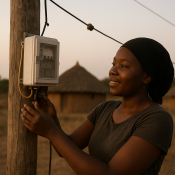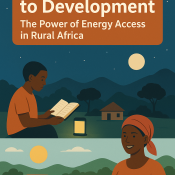
Lighting Up Lives: How Rural Electrification Transforms Communities
Across the world, electricity is more than just a modern convenience — it’s a lifeline. In rural communities, the arrival of electric power often marks the beginning of a new chapter — one filled with opportunity, innovation, and hope. Rural electrification is not just about wiring poles or installing transformers; it’s about lighting up lives and transforming the very fabric of society.
1. From Darkness to Development
In many developing regions, particularly across Africa and Asia, millions of people still live without access to electricity. For these communities, nightfall often means a halt in productivity. Children struggle to study by the dim light of kerosene lamps, small businesses shut down early, and local clinics operate under unsafe and unreliable lighting conditions.
When electricity arrives, everything changes. Streetlights extend productive hours, allowing shops to stay open longer. Schools can use electronic learning tools, and health centers can refrigerate vaccines and run essential equipment. Suddenly, communities are not just surviving — they’re thriving.
2. Powering Education and Knowledge
Electricity brings with it the light of learning. In electrified rural schools, students can study after sunset, teachers can use digital tools, and educational content becomes more accessible. The simple act of lighting a classroom can mean the difference between a child dropping out and one achieving academic success.
Moreover, access to power supports digital inclusion. Rural electrification enables the use of computers, internet access, and mobile charging — key tools that connect rural youth to the wider world and new learning opportunities.
3. Empowering Women and Households
The impact of electricity on gender equality is profound. In many rural settings, women spend long hours on domestic chores like fetching firewood or processing food manually. Electrification introduces appliances and technologies that reduce labor, freeing up time for education, entrepreneurship, and civic participation.
Women-led businesses — tailoring shops, food processing ventures, hair salons, and cold stores — thrive where power is available. Electrification empowers women not just economically, but socially, creating ripples of transformation across families and generations.
4. Boosting Local Economies and Entrepreneurship
Electricity sparks local enterprise. With reliable power, small businesses can flourish — from welders and millers to barbers and internet cafés. Rural electrification also attracts investment, enabling agricultural value chains such as processing, packaging, and storage, which reduce waste and increase income for farmers.
Microgrids and renewable energy systems have become game changers in this area. They offer affordable, sustainable power to remote regions while stimulating innovation and self-sufficiency.
5. Enhancing Healthcare and Quality of Life
A powered clinic is a life-saving facility. Electricity ensures the availability of lighting during childbirth, refrigeration for vaccines, and reliable operation of medical devices. It also supports communication systems that connect rural doctors with specialists in cities.
Beyond health facilities, electrification improves overall well-being. Access to entertainment, news, and information through radio and television fosters social awareness and civic participation.
6. Sustainability and the Future of Energy Access
The journey of rural electrification is increasingly tied to sustainability. Solar mini-grids, wind turbines, and hybrid systems are leading the charge, providing clean and affordable energy without the environmental toll of fossil fuels. These renewable solutions are not only expanding access but also preparing communities for a greener and more resilient future.

Conclusion: Light as a Symbol of Progress
Every time a bulb flickers on in a once-dark village, it symbolizes far more than light — it represents dignity, progress, and hope. Rural electrification is the heartbeat of development, the spark that ignites education, health, enterprise, and equality.
As governments, energy providers, and private innovators continue to collaborate, the goal is clear: to ensure that no community remains in darkness. Because when we light up lives, we light up the future.




